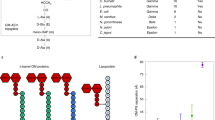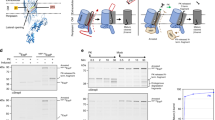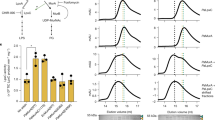Abstract
Gram-negative bacteria are surrounded by a cell envelope that comprises an outer membrane (OM) and an inner membrane that, together, delimit the periplasmic space, which contains the peptidoglycan (PG) sacculus. Covalent anchoring of the OM to the PG is crucial for envelope integrity in Escherichia coli. When the OM is not attached to the PG, the OM forms blebs and detaches from the cell. The Braun lipoprotein Lpp1 covalently attaches OM to the PG but is present in only a small number of γ-proteobacteria; the mechanism of OM–PG attachment in other species is unclear. Here, we report that the OM is attached to PG by covalent cross-links between the N termini of integral OM β-barrel-shaped proteins (OMPs) and the peptide stems of PG in the α-proteobacteria Brucella abortus and Agrobacterium tumefaciens. Cross-linking is catalysed by l,d-transpeptidases and attached OMPs have a conserved alanyl-aspartyl motif at their N terminus. Mutation of the aspartate in this motif prevents OMP cross-linking and results in OM membrane instability. The alanyl-aspartyl motif is conserved in OMPs from Rhizobiales; it is therefore feasible that OMP–PG cross-links are widespread in α-proteobacteria.
This is a preview of subscription content, access via your institution
Access options
Access Nature and 54 other Nature Portfolio journals
Get Nature+, our best-value online-access subscription
$29.99 / 30 days
cancel any time
Subscribe to this journal
Receive 12 digital issues and online access to articles
$119.00 per year
only $9.92 per issue
Buy this article
- Purchase on Springer Link
- Instant access to full article PDF
Prices may be subject to local taxes which are calculated during checkout



Similar content being viewed by others
Data availability
All data are available at Figshare (https://doi.org/10.6084/m9.figshare.c.5087120) and raw MS data were deposited at the ProteomeXchange Consortium through the PRIDE44 partner repository with the dataset identifier PXD019023. Source data are provided with this paper.
Code availability
The ImageJ script written for periplasm measurement is available on GitHub (https://github.com/pgodessa/PeriSizer).
References
Asmar, A. T. & Collet, J. F. Lpp, the Braun lipoprotein, turns 50—major achievements and remaining issues. FEMS Microbiol. Lett. 365, fny199 (2018).
Suzuki, H. et al. Murein-lipoprotein of Escherichia coli: a protein involved in the stabilization of bacterial cell envelope. Mol. Gen. Genet. 167, 1–9 (1978).
Asmar, A. T. et al. Communication across the bacterial cell envelope depends on the size of the periplasm. PLoS Biol. 15, e2004303 (2017).
Cohen, E. J., Ferreira, J. L., Ladinsky, M. S., Beeby, M. & Hughes, K. T. Nanoscale-length control of the flagellar driveshaft requires hitting the tethered outer membrane. Science 356, 197–200 (2017).
Diao, J. et al. Peptidoglycan association of murein lipoprotein is required for KpsD-dependent group 2 capsular polysaccharide expression and serum resistance in a uropathogenic Escherichia coli Isolate. mBio 8, e00603-17 (2017).
Moreno, E. & Moriyon, I. in The Prokaryotes Vol. 5 (Dworkin, M. et al.) Ch. 3.1.16, 315–456 (Springer, 2006).
Halim, A. et al. Assignment of saccharide identities through analysis of oxoniumion fragmentation profiles in LC–MS/MS of glycopeptides. J. Proteome Res. 13, 6024–6032 (2014).
Magnet, S. et al. Identification of the l,d-transpeptidases responsible for attachment of the Braun lipoprotein to Escherichia coli peptidoglycan. J. Bacteriol. 189, 3927–3931 (2007).
Mainardi, J. L. et al. A novel peptidoglycan cross-linking enzyme for a β-lactam-resistant transpeptidation pathway. J. Biol. Chem. 280, 38146–38152 (2005).
Braun, V. & Bosch, V. Sequence of the murein-lipoprotein and the attachment site of the lipid. Eur. J. Biochem. 28, 51–69 (1972).
Gamazo, C. & Moriyon, I. Release of outer membrane fragments by exponentially growing Brucella melitensis cells. Infect. Immun. 55, 609–615 (1987).
Sandoz, K. M. et al. Nat. Microbiol. https://doi.org/10.1038/s41564-020-00798-4 (2020).
Deghelt, M. et al. G1-arrested newborn cells are the predominant infectious form of the pathogen Brucella abortus. Nat. Commun. 5, 4366 (2014).
Moriyon, I. & Berman, D. T. Isolation, purification, and partial characterization of Brucella abortus matrix protein. Infect. Immun. 39, 394–402 (1983).
Wheeler, R., Mesnage, S., Boneca, I. G., Hobbs, J. K. & Foster, S. J. Super-resolution microscopy reveals cell wall dynamics and peptidoglycan architecture in ovococcal bacteria. Mol. Microbiol. 82, 1096–1109 (2011).
Keller, A., Nesvizhskii, A. I., Kolker, E. & Aebersold, R. Empirical statistical model to estimate the accuracy of peptide identifications made by MS/MS and database search. Anal. Chem. 74, 5383–5392 (2012).
Nesvizhskii, A. I., Keller, A., Kolker, E. & Aebersold, R. A statistical model for identifying proteins by tandem mass spectrometry. Anal. Chem. 75, 4646–4658 (2003).
Peters, K. et al. Copper inhibits peptidoglycan ld-transpeptidasessuppressing β-lactam resistance due to bypass of penicillin-binding proteins. Proc. Natl Acad. Sci. USA 115, 10786–10791 (2018).
Schindelin, J. et al. Fiji: an open-source platform for biological-image analysis. Nat. Methods 9, 676–682 (2012).
Ducret, A., Quardokus, E. M. & Brun, Y. V. MicrobeJ, a tool for high throughput bacterial cell detection and quantitative analysis. Nat. Microbiol. 1, 16077 (2016).
Herrou, J. et al. Periplasmic protein EipA determines envelope stress resistance and virulence in Brucella abortus. Mol. Microbiol. 111, 637–661 (2019).
Zheng, S. Q. et al. MotionCor2: anisotropic correction of beam-induced motion for improved cryo-electron microscopy. Nat. Methods 14, 331–332 (2017).
Rohou, A. & Grigorieff, N. CTFFIND4: fast and accurate defocus estimation from electron micrographs. J. Struct. Biol. 192, 216–221 (2015).
Goujon, M. et al. A new bioinformatics analysis tools framework at EMBL-EBI. Nucleic Acids Res. 38, W695–W699 (2010).
Li, W. et al. The EMBL-EBI bioinformatics web and programmatic tools framework. Nucleic Acids Res. 43, W580–W584 (2015).
McWilliam, H. et al. Analysis tool web services from the EMBL-EBI. Nucleic Acids Res. 41, W597–W600 (2013).
Petersen, T. N., Brunak, S., von Heijne, G. & Nielsen, H. SignalP 4.0: discriminating signal peptides from transmembrane regions. Nat. Methods 8, 785–786 (2011).
Capella-Gutierrez, S., Silla-Martinez, J. M. & Gabaldon, T. trimAl: a tool for automated alignment trimming in large-scale phylogenetic analyses. Bioinformatics 25, 1972–1973 (2009).
Lefort, V., Longueville, J. E. & Gascuel, O. SMS: smart model selection in PhyML. Mol. Biol. Evol. 34, 2422–2424 (2017).
Guindon, S. et al. New algorithms and methods to estimate maximum-likelihood phylogenies: assessing the performance of PhyML 3.0. Syst. Biol. 59, 307–321 (2010).
Guindon, S. & Gascuel, O. A simple, fast, and accurate algorithm to estimate large phylogenies by maximum likelihood. Syst. Biol. 52, 696–704 (2003).
Gascuel, O. BIONJ: an improved version of the NJ algorithm based on a simple model of sequence data. Mol. Biol. Evol. 14, 685–695 (1997).
Letunic, I. & Bork, P. Interactive Tree Of Life (iTOL) v4: recent updates and new developments. Nucleic Acids Res. 47, W256–W259 (2019).
Kanehisa, M. Toward understanding the origin and evolution of cellular organisms. Protein Sci. 28, 1947–1951 (2019).
Kanehisa, M. & Goto, S. KEGG: Kyoto Encyclopedia of Genes and Genomes. Nucleic Acids Res. 28, 27–30 (2000).
Kanehisa, M., Sato, Y., Furumichi, M., Morishima, K. & Tanabe, M. New approach for understanding genome variations in KEGG. Nucleic Acids Res. 47, D590–D595 (2019).
Dereeper, A. et al. Phylogeny.fr: robust phylogenetic analysis for the non-specialist. Nucleic Acids Res. 36, W465–W469 (2008).
Castresana, J. Selection of conserved blocks from multiple alignments for their use in phylogenetic analysis. Mol. Biol. Evol. 17, 540–552 (2000).
Darriba, D., Taboada, G. L., Doallo, R. & Posada, D. jModelTest 2: more models, new heuristics and parallel computing. Nat. Methods 9, 772 (2012).
Altschul, S. F. et al. Gapped BLAST and PSI-BLAST: a new generation of protein database search programs. Nucleic Acids Res. 25, 3389–3402 (1997).
Boratyn, G. M. et al. Domain enhanced lookup time accelerated BLAST. Biol. Direct 7, 12 (2012).
Schaffer, A. A. et al. Improving the accuracy of PSI-BLAST protein database searches with composition-based statistics and other refinements. Nucleic Acids Res. 29, 2994–3005 (2001).
Waterhouse, A. M., Procter, J. B., Martin, D. M., Clamp, M. & Barton, G. J. Jalview version 2—a multiple sequence alignment editor and analysis workbench. Bioinformatics 25, 1189–1191 (2009).
Perez-Riverol, Y. et al. The PRIDE database and related tools and resources in 2019: improving support for quantification data. Nucleic Acids Res. 47, D442–D450 (2019).
Roy, A., Kucukural, A. & Zhang, Y. I-TASSER: a unified platform for automated protein structure and function prediction. Nat. Protoc. 5, 725–738 (2010).
Yang, J. et al. The I-TASSER Suite: protein structure and function prediction. Nat. Methods 12, 7–8 (2015).
Zhang, Y. I-TASSER server for protein 3D structure prediction. BMC Bioinform. 9, 40 (2008).
Acknowledgements
We thank the members of the URBM for their discussions of the data; F. Tilquin and M. Waroquier for their logistic support; P. Cherry and C. Servais for their help with this project; V. Vassen for the B. abortus strains; C. Demazy for the MS sample preparation; I. Moriyon for his insights and ideas; S. Gillet for his help and knowledge regarding the script; S. Mesnage for sharing the amidase expression vector, M. Boutry for the A. tumefaciens strain and A. Asmar for the Lpp antibody; A. Cehovin and E. Lawarée for their reading of the manuscript; and staff at UNamur (https://www.unamur.be/) for financial and logistical support. P.G. was supported by a FRIA PhD fellowship. S.E.V.d.V. is supported by a FWO PhD fellowship. This work was funded by the Fédération Wallonie-Bruxelles (no. ARC 17/22-087), and by the FRS-FNRS (nos. PDR T.0060.15 and T.0058.20).
Author information
Authors and Affiliations
Contributions
A.L. conducted PG extraction of A. tumefaciens. M.D. and P.R. performed the MS analysis. S.E.V.d.V. and H.R. performed the EM sample preparation and image acquisition. P.G. performed all of the other experiments. P.S. contributed to the initial conception of the work. P.G. and X.D.B. designed the experiments. P.G., X.D.B. and J.-F.C. wrote the manuscript.
Corresponding author
Ethics declarations
Competing interests
The authors declare no competing interests.
Additional information
Publisher’s note Springer Nature remains neutral with regard to jurisdictional claims in published maps and institutional affiliations.
Extended data
Extended Data Fig. 1 MS-MS fragmentation spectra of OMPs N-terminal peptides.
a, Left panel, spectra obtained for Omp2b/31/W/P and BAB1_0729 from the analysis of lysozyme treated samples. PG disaccharide (NAG-NAM) modifications are indicated by « GL » on the sequence. Right panel, enlargement of the left spectra from 150 to 220 M/Z ratio. Glycosylation of peptides is confirmed by the presence of saccharide oxonium ions: HexNAc, [C8H14NO5]+ with a mass of 204.087; HexNAc*, HexNAc – H2O, [C8H12NO4]+ with a mass of 186.076 and HexNAc**, HexNAc – 2 H2O, [C8H10NO3]+ with a mass of 168.066. J corresponds to mDAP. b, Fragmentation spectra of the N-terminal peptides of Omp25 and 25c were obtained upon treatment with the amidase. The absence of glycosylation is due to the amidase activity.
Extended Data Fig. 2 Peptidoglycan binding induces a shift in the migration of Omp2b and Omp25 in Western blot.
Upon digestion of purified B. abortus peptidoglycan with lysozyme, an apparent heavier weight is observed for Omp2b (left) and Omp25 (right) compared to the signal obtained with a lysate. A signal is observed in the stacking gel when the purified peptidoglycan is undigested. S, stacking gel; R, running gel; L, lysate; PG, peptidoglycan; PGD, lysozyme-digested peptidoglycan. This experiment was not repeated. The shift induced by the PG binding is consistently observed in Fig. 3b.
Extended Data Fig. 3 Ldt1, Ldt2 and Ldt4 form a monophyletic cluster.
Bootstrap values are represented above branches.
Extended Data Fig. 4 Ldt4 has an impact on the linkage of Omp25 and Omp2b.
Effect of the deletion of the eight ldt genes in B. abortus. The ldt4 strain and derivatives (∆ldt1,4, ∆ldt2,4 and ∆ldt1,2,4) have a noticeable effect on the linkage of Omp25 and Omp2b. An increased signal corresponding to the free form of both OMPs is observed in these strains. GcrA was used as loading control.
Extended Data Fig. 5 Δldt1,2,4 has no phenotype defect under normal growth conditions but is more sensitive to heat.
a, Cryo-EM imaging of WT and Δldt1,2,4 strains (« ∆ »). No obvious defect can be seen between both strains. Enlarged portion delimited with coloured squares is shown in detail with the same colour code. Images were acquired with a defocus in the range of −7 to −10 µm. IM, inner membrane; OM, outer membrane. b, Comparison of the periplasm size distribution between the WT and the Δldt1,2,4 strains. From 3 biological replicates, 24 cells were used and 180,965 measures were taken for the WT strain and 187,580 measures were obtained from 27 cells for the mutant. No significant difference was observed in the periplasm size between both strains. c Heat-stressed ldt1 and ldt2 strains have a WT-like phenotype for the release of Omp25 in culture supernatant. These results support the previous observations that Ldt1 and Ldt2 do not seem to have a major role in the OMP anchorage under normal growth conditions. This experiment is representative of 2 biologically independent replicates.
Extended Data Fig. 6 Infectivity is not impacted in the Omp25-2bD2A or Δldt1,2,4 strains.
Murine RAW 264.7 macrophages were infected with Brucella abortus 544 WT, Omp25-2bD2A, Δldt1,2,4 or Δldt1,2,4c strains. Entry was assessed at 2 h post-infection (PI), survival at 5 h PI and replication at 24 h and 48 h PI. No difference was observed between the WT and the mutants. n = 3 biologically independent experiments, error bars, mean ± s.d.
Extended Data Fig. 7 Omp25D2A and Omp2bD2A are exported in the OM and detectable on the surface.
a, Immunolabelling of Omp25 on the WT, omp25D2A and Δomp25 strains. A signal similar to the WT is observed in the omp25D2A, suggesting a normal export of Omp25 and insertion at the OM. b, Immunolabelling of Omp2b on the WT and omp2bD2A strains. As for Omp25D2A, Omp2bD2A is detectable on the bacterial surface. Scale bar is 2 µm.
Extended Data Fig. 8 Omp25-2bD2A strain has an envelope defect.
a, The aspect ratio (major axis/minor axis) of both the WT and the Omp25-2bD2A strains was calculated and sorted according to their frequency. A shift of the distribution towards lower aspect ratios is observed for the mutant strains reflecting rounder cell shape. Statistical significance was determined using two-tailed unpaired t-tests with the Holm-Sidak method (with P<0.05), n = 2889 for WT and 3644 for Omp25-2bD2A strains cells examined over 3 independent experiments, error bars, mean ± s.d. b, Western blot analysis of the WT and D2A OMPs strains supernatants after incubation at different temperatures. The Omp25-2bD2A already release Omp25 at growth temperature indicating an outer-membrane instability.
Extended Data Fig. 9 Agrobacterium tumefaciens has a similar structure for the OMP-PG link to that of B. abortus.
a, Classification of the 379 proteins isolated with PG and identified in mass spectrometry according to the number of spectra per protein and their subcellular localisation. Numbers in brackets correspond to the number of proteins predicted per subcellular localisation. C, Cytoplasmic; IM, Inner Membrane; P, Periplasmic; OM, Outer Membrane; E, extracellular. b, Three-dimensional predicted structure of the two predominant protein (Atu1020/1021, left; Atu1131, right) identified by mass spectrometry. Prediction were made using protein sequences without signal peptides and the I-TASSER server44,45,46, and displayed with PyMol v.2.0. c, Spectra obtained for Atu1020/1021 and Atu1131 upon analysis of lysozyme treated samples. PG disaccharide (NAG-NAM) modifications are indicated by « GL » on the sequence. Glycosylation of peptides is confirmed by the presence of saccharide oxonium ions on the enlargement of the left spectra from 150 to 220 M/Z ratio. Glycosylation of peptides is confirmed by the presence of saccharide oxonium ions: HexNAc, [C8H14NO5]+ with a mass of 204.087; HexNAc*, HexNAc – H2O, [C8H12NO4]+ with a mass of 186.076 and HexNAc**, HexNAc – 2 H2O, [C8H10NO3]+ with a mass of 168.066. J corresponds to mDAP.
Supplementary information
Supplementary Information
Supplementary Figs. 1 and 2, Tables 1–6 and references.
Source data
Source Data Fig. 1
List of B. abortus identified proteins and their associated number of read and predicted localization.
Source Data Fig. 2
Unprocessed western blots.
Source Data Fig. 3
Unprocessed western blots.
Source Data Extended Data Fig. 4
Unprocessed western blots.
Source Data Extended Data Fig. 5
Unprocessed western blots.
Source Data Extended Data Fig. 6
Unprocessed western blots.
Source Data Extended Data Fig. 8
Numerical data for Extended Data Fig. 8a (A for mutant and W for WT).
Source Data Extended Data Fig. 8
Unprocessed western blots for Extended Data Fig. 8b.
Source Data Extended Data Fig. 9
List of A. tumefaciens identified proteins and their associated number of reads and predicted localization.
Rights and permissions
About this article
Cite this article
Godessart, P., Lannoy, A., Dieu, M. et al. β-Barrels covalently link peptidoglycan and the outer membrane in the α-proteobacterium Brucella abortus. Nat Microbiol 6, 27–33 (2021). https://doi.org/10.1038/s41564-020-00799-3
Received:
Accepted:
Published:
Issue Date:
DOI: https://doi.org/10.1038/s41564-020-00799-3
This article is cited by
-
A distinctive family of L,D-transpeptidases catalyzing L-Ala-mDAP crosslinks in Alpha- and Betaproteobacteria
Nature Communications (2024)
-
Lipopolysaccharide biosynthesis and traffic in the envelope of the pathogen Brucella abortus
Nature Communications (2023)
-
Physical properties of the bacterial outer membrane
Nature Reviews Microbiology (2022)
-
An ancient divide in outer membrane tethering systems in bacteria suggests a mechanism for the diderm-to-monoderm transition
Nature Microbiology (2022)
-
Peptidoglycan maturation controls outer membrane protein assembly
Nature (2022)



